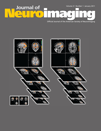In Vivo Serial MR Imaging Evaluates Neointimal Hyperplasia Inhibited by Intravenously Transfused Endothelial Progenitor Cells in Carotid Artery Injured Mice
J Neuroimaging 2011;21:49-55.
Abstract
ABSTRACT
PURPOSE
To study the feasibility of in vivo MR imaging in evaluation of endothelial progenitor cells (EPCs) on the progress of neointimal hyperplasia after carotid artery injury in mice.
METHODS
Fifteen Kunming mice were injured in left carotid artery by removal of endothelium with a flexible wire 7 days after splenectomy. EPCs were collected by in vitro culture of spleen-derived mouse mononuclear cells (MNCs) in endothelial basal medium. After artery injury, the mice received EPCs (n= 6), phosphate buffered solution (PBS) (n= 6), and DiI-Ac-LDL labeled EPCs (n= 3) intravenously. In vivo serial MR imaging were performed at different time points after artery injury, and vessel-wall thickness and vessel-wall area at injury site were measured on MR imaging.
RESULTS
Transfused Dil-Ac-LDL-labeled EPCs were found at the injury site by histopathological analyses. Vessel wall of injured artery was observed and quantitatively analyzed with MR imaging. Vessel-wall thickness was .487 ± .122 mm in the non-EPCs transfusion group and .294 ± .051 mm in the EPCs transfusion group 15 days after artery injury (P= .005). While vessel-wall area was .860 ± .182 mm2 in the non-EPCs transfusion group and .468 ± .141 mm2 in the EPCs transfusion group 15 days after artery injury (P= .002). Therefore, the neointimal hyperplasia of injured artery in the EPCs transfusion group was lesser than that in the non-EPCs transfusion group.
CONCLUSION
Neointimal hyperplasia can be reduced by intravenous transfusion of EPCs and analyzed on in vivo MR imaging after vascular injury.




